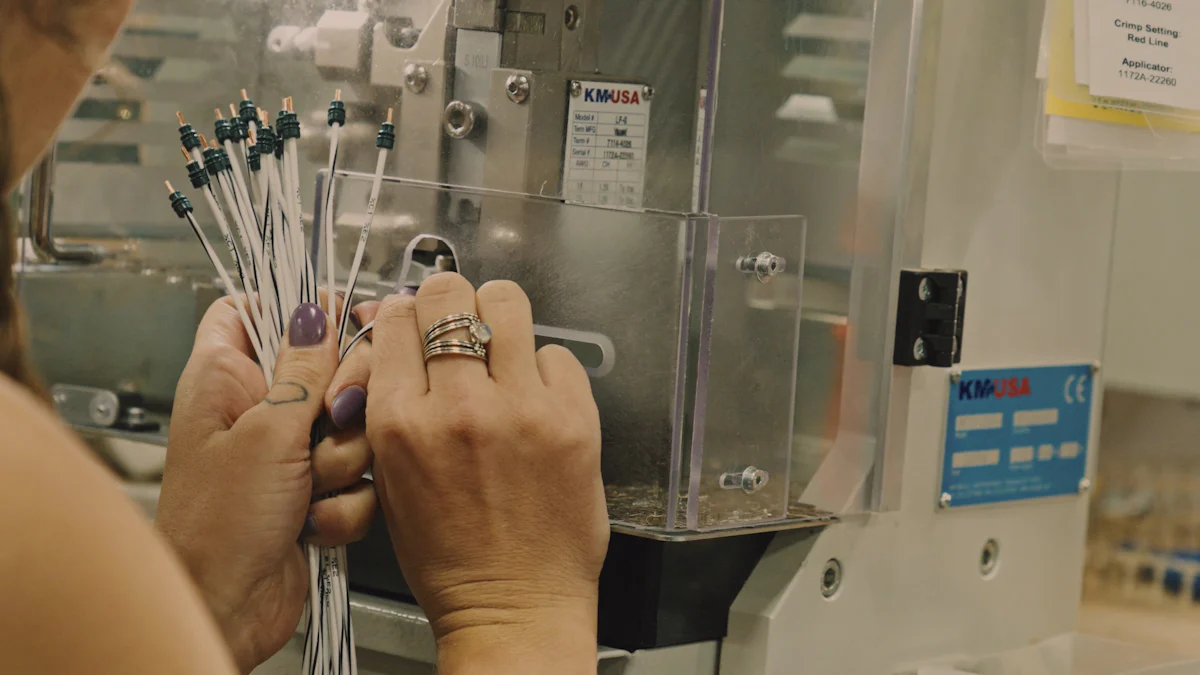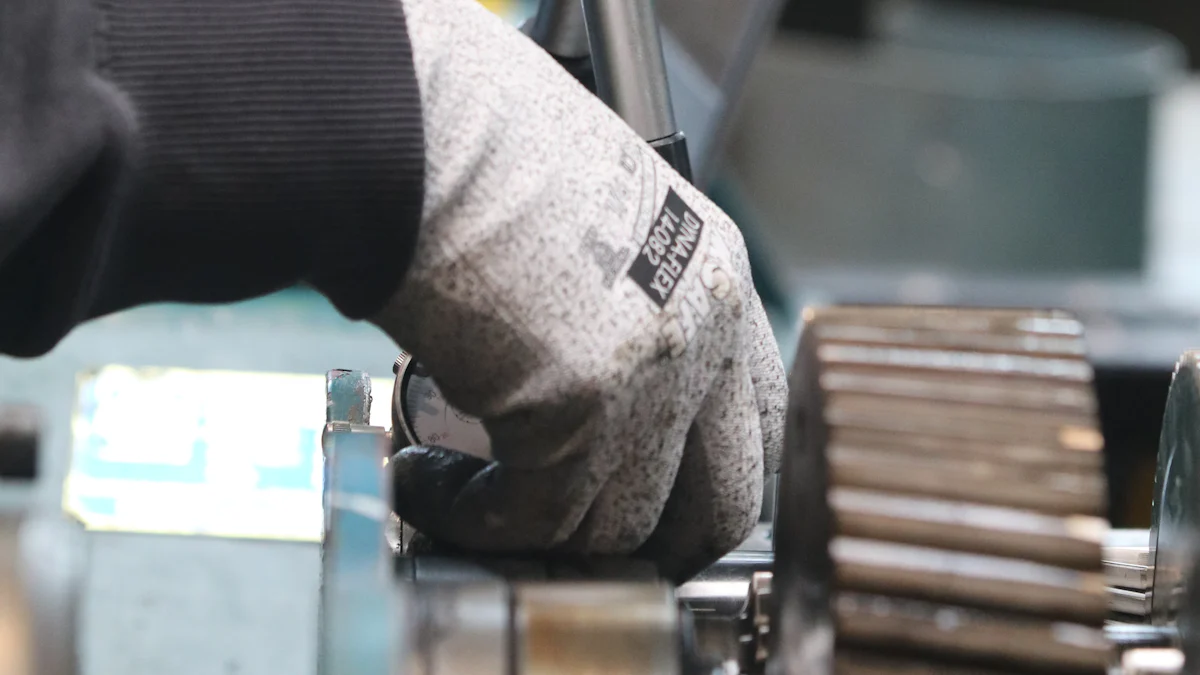
Die Rapid Thermal Processing (RTP) revolutioniert die Halbleiterfertigung, indem sie schnelle und präzise thermische Behandlungen anbietet. Ich finde es faszinierend, wie RTP die Produktionseffizienz verbessert, insbesondere im Vergleich zu herkömmlichen Methoden. Der RTP-Trägerprozess spielt dabei eine zentrale Rolle. Es sorgt für eine gleichmäßige Erwärmung und minimiert Verschmutzungen, was für die Erhaltung der Qualität von Halbleiterscheiben entscheidend ist. Dieser Prozess beschleunigt nicht nur die Produktion, sondern erhöht auch die Zuverlässigkeit und Leistung von elektronischen Komponenten. In Nordamerika unterstreicht die Präsenz führender Halbleiterhersteller die Bedeutung der RTP-Technologie bei der Entwicklung der Branche.
Wichtigste Erkenntnisse
- RTP beschleunigt die Halbleiterfertigung erheblich, wodurch die Wärmeverarbeitungszeiten von Stunden auf wenige Minuten reduziert werden, was die Gesamtproduktionseffizienz erhöht.
- Das RTP-Trägerverfahren gewährleistet eine gleichmäßige Erwärmung und minimiert Verschmutzungen, entscheidend für die Erhaltung der Qualität und Zuverlässigkeit von Halbleiterscheiben.
- Die Präzision bei thermischen Behandlungen ist ein Markenzeichen von RTP, das konsequente Ergebnisse in kritischen Prozessen wie Dotieraktivierung und Silizidbildung ermöglicht.
- Die Implementierung von RTP-Technologie kann zu höheren Erträgen und einer verbesserten Geräteleistung führen, was sie zu einer wertvollen Investition für Hersteller macht.
- Zukünftige Fortschritte in RTP, einschließlich KI-Integration und neue Trägermaterialien, versprechen, die Effizienz und Präzision in der Halbleiterfertigung weiter zu verbessern.
- Die Umstellung auf RTP erfordert eine sorgfältige Planung und Zusammenarbeit mit Geräteherstellern, um die Kompatibilität mit bestehenden Prozessen zu gewährleisten.
- Die Aktualisierung der Best Practices und Innovationen in der Branche ist wesentlich für die Bewältigung der Herausforderungen und die Maximierung der Vorteile der RTP-Technologie.
RTP Carrier Process verstehen

Definition und Grundprinzipien von RTP
Rapid Thermal Processing (RTP) fasziniert mich mit seiner Fähigkeit, die Halbleiterfertigung zu transformieren. Diese Technologie erhitzt Siliziumwafer in wenigen Sekunden auf hohe Temperaturen. Ich finde es erstaunlich, wie RTP präzise thermische Behandlungen für fortgeschrittene Mikrochip-Produktion erreicht. Bei dem Verfahren handelt es sich um einen schnellen Heizzyklus, gefolgt von einer gesteuerten Kühlphase. Dadurch wird sichergestellt, dass die Wafer eine gleichmäßige thermische Belichtung erhalten, was für die Aufrechterhaltung ihrer Qualität und Leistung entscheidend ist.
Der RTP-Träger spielt dabei eine wichtige Rolle. Es unterstützt die Wafer während der schnellen thermischen Zyklen, um sicherzustellen, dass sie stabil und frei von Verschmutzung bleiben. Durch die Verwendung von Materialien wie Graphit bietet der RTP-Träger eine ausgezeichnete Wärmeleitfähigkeit und Stabilität. Dies ermöglicht eine effiziente Wärmeübertragung und minimiert das Risiko einer Beschädigung der Wafer.
Vorteile von RTP
Geschwindigkeit und Effizienz
Eine der herausragenden Eigenschaften von RTP ist seine Geschwindigkeit. Traditionelle thermische Verarbeitungsmethoden können Stunden dauern, aber RTP beendet die gleichen Aufgaben in Minuten. Diese schnelle Zykluszeit erhöht die Produktionseffizienz deutlich. Ich weiß zu schätzen, wie diese Geschwindigkeit die Qualität der Wafer nicht beeinträchtigt. Stattdessen erhöht es sie durch die Verringerung der Zeit, die sie hohen Temperaturen ausgesetzt sind, was zu Defekten führen kann.
Präzision und Steuerung in thermischen Behandlungen
Precision ist ein weiteres Markenzeichen von RTP. Die Technologie bietet eine beispiellose Kontrolle über Temperatur und Timing. Diese Präzision ist für Prozesse wie Dotieraktivierung und Silizidbildung von entscheidender Bedeutung, bei denen auch geringe Variationen das Endprodukt beeinflussen können. Mit RTP kann ich einheitliche Ergebnisse erzielen, um sicherzustellen, dass jeder Wafer die strengen Standards erfüllt, die für fortgeschrittene Halbleiterbauelemente erforderlich sind.
Anwendungen von RTP in der Halbleiterfertigung

Rapid Thermal Processing (RTP) ist ein Spielwechsler in der Halbleiterfertigung geworden. Ich finde es unglaublich, wie diese Technologie sowohl die Geschwindigkeit als auch die Präzision verschiedener Prozesse erhöht. Lassen Sie uns in einige spezielle Anwendungsfälle eintauchen und sehen, wie RTP einen Unterschied macht.
Spezifische Anwendungsfälle
Annealing- und Oxidationsprozesse
Annealing und Oxidation sind entscheidende Schritte in der Halbleiterfertigung. RTP zeichnet sich in diesen Bereichen durch schnelle und gleichmäßige Erwärmung aus. Ich weiß zu schätzen, wie RTP sicherstellt, dass jeder Wafer eine konsistente thermische Behandlung erhält, die für die Erhaltung der Qualität unerlässlich ist. Der RTP-Träger spielt hier eine wichtige Rolle. Er unterstützt die Wafer bei diesen Hochtemperaturprozessen, sorgt für Stabilität und Minimierung von Verunreinigungen. Dies führt zu höheren Ausbeuten und weniger Mängeln, was für jeden Hersteller ein Gewinn ist.
Dopant-Aktivierung und Silizid-Formation
Dopant Aktivierung und Silizidbildung erfordern eine präzise Temperaturregelung. RTP bietet genau das. Ich liebe, wie RTP schnelle thermische Zyklen ermöglicht, die für die Aktivierung von Dopants unerlässlich sind, ohne Beschädigung der Wafer zu verursachen. Der RTP-Träger sorgt dafür, dass die Wafer während des Prozesses stabil bleiben und zu konsistenten und zuverlässigen Ergebnissen führen. Diese Präzision ist entscheidend für die Herstellung von fortschrittlichen Halbleiterbauelementen, die Industriestandards erfüllen.
Auswirkungen auf die Fertigungseffizienz
RTP verbessert nicht nur spezifische Prozesse, sondern erhöht auch die Gesamtproduktionseffizienz. Hier ist wie:
Reduzierung der Zykluszeit
Einer der herausragenden Vorteile von RTP ist seine Fähigkeit, Zykluszeit zu reduzieren. Traditionelle Methoden können zeitraubend sein, aber RTP schließt thermische Behandlungen in Minuten. Diese schnelle Verarbeitung bedeutet, dass ich mehr Wafer in weniger Zeit produzieren kann, Durchsatz und Rentabilität erhöhen. Der RTP-Träger erhöht diese Effizienz durch eine gleichmäßige Wärmeverteilung, was den Bedarf an Nacharbeiten reduziert.
Verbesserung der Geräteleistung
RTP beschleunigt nicht nur die Produktion, sondern verbessert auch die Geräteleistung. Die präzise thermische Steuerung von RTP sorgt dafür, dass jeder Wafer die strengen Anforderungen moderner Halbleitergeräte erfüllt. Ich finde es faszinierend, wie diese Technologie zu leistungsfähigen Chips führt, die für die heutige tech-getriebene Welt unerlässlich sind. Die Rolle des RTP-Trägers bei der Aufrechterhaltung der Waferqualität kann nicht überschätzt werden, da er die Zuverlässigkeit und Leistungsfähigkeit des Endprodukts direkt beeinflusst.
Vergleich mit anderen Annealing Technologies
Die Nutzung verschiedener Glühtechnologien in der Halbleiterfertigung zeigt faszinierende Kontraste. Ich finde es spannend, wie jede Methode einzigartige Vorteile und Herausforderungen bietet. Tauchen wir in den Vergleich zwischen Rapid Thermal Processing (RTP) und anderen beliebten Techniken wie Ofen- und Laserglühen.
RTP gegen Furnace Annealing
Unterschiede in Prozess und Ergebnis
Furnace-Annealing ist seit Jahrzehnten ein Grund für die Halbleiterfertigung. Es handelt sich um Heizwafer in einer großen Kammer über längere Zeiträume. Dieses Verfahren gewährleistet eine gleichmäßige Temperaturverteilung, fehlt aber oft an Geschwindigkeit und Präzision von RTP. Im Gegensatz dazu erhitzt RTP Wafer schnell und erreicht in Sekunden hohe Temperaturen. Diese schnelle Zykluszeit ermöglicht präzise thermische Behandlungen, die für die fortgeschrittene Mikrochip-Produktion unerlässlich sind.
Die Ergebnisse unterscheiden sich auch deutlich. Die Ofenglühung kann zu längeren Produktionszeiten und zu einem erhöhten Energieverbrauch führen. RTP hingegen reduziert Zykluszeit und Energienutzung und macht es zu einer effizienteren Wahl für moderne Fertigungsbedürfnisse.
Vor- und Nachteile jeder Methode
Furnace Glühen bietet den Vorteil der Gleichmäßigkeit und Einfachheit. Es ist eine bewährte Methode, die viele Hersteller vertrauen. Seine langsamere Verarbeitungszeit kann jedoch nachteilig sein, insbesondere wenn eine schnelle Produktion entscheidend ist.
RTP strahlt mit seiner Geschwindigkeit und Präzision. Ich weiß zu schätzen, wie es die Produktionseffizienz erhöht, ohne die Qualität zu beeinträchtigen. Der RTP-Träger spielt hier eine wichtige Rolle, um eine gleichmäßige Erwärmung und Minimierung von Verunreinigungen zu gewährleisten. RTP-Systeme können jedoch anfangs teurer implementiert werden, was einige Hersteller abschrecken könnte.
RTP gegen Laser Annealing
Technologische Distinktionen
Die Laserglühung stellt einen weiteren innovativen Ansatz dar. Es verwendet Laserstrahlen, um bestimmte Flächen des Wafers zu erhitzen, wodurch eine lokalisierte Behandlung ermöglicht wird. Diese Methode bietet unglaubliche Präzision, die für bestimmte Anwendungen von Vorteil ist. Es kann jedoch nicht die für einige Prozesse erforderliche Gleichmäßigkeit bieten.
RTP bietet dagegen eine Balance zwischen Geschwindigkeit und Gleichmäßigkeit. Es erwärmt den gesamten Wafer schnell und gleichmäßig, so dass es für eine breite Palette von Anwendungen geeignet. Der RTP-Träger sorgt für Stabilität während dieser schnellen Zyklen und verbessert den gesamten Prozess.
Application-Specific Advantages
Laserglühen zeichnet sich durch Anwendungen aus, die eine lokalisierte Behandlung erfordern. Es ist perfekt für Prozesse, bei denen Präzision an erster Stelle steht. Sein begrenzter Umfang kann jedoch für breitere Anwendungen nachteilig sein.
RTPs Vielseitigkeit macht es zu einer bevorzugten Wahl für viele Hersteller. Ich finde es faszinierend, wie es sich an verschiedene Prozesse anpasst, von der Glühung bis zur Oxidation. Der RTP-Träger verbessert diese Anpassungsfähigkeit durch hervorragende Wärmeleitfähigkeit und Stabilität. Diese Vielseitigkeit übersetzt eine verbesserte Fertigungseffizienz und Geräteleistung.
Technische Überlegungen und Herausforderungen
Das Navigieren der Welt der Rapid Thermal Processing (RTP) beinhaltet das Verständnis seiner technischen Überlegungen und Herausforderungen. Ich finde diesen Aspekt entscheidend für jeden, der RTP in der Halbleiterfertigung implementieren möchte.
Implementierung Herausforderungen
Ausrüstung und Kostenerwägungen
Die Implementierung von RTP-Technologie erfordert erhebliche Investitionen in spezialisierte Geräte. Die Lampbasierte RTP Systeme eine gemeinsame Wahl aufgrund ihrer Fähigkeit, schnelle und gleichmäßige Heizung zu bieten. Diese Systeme sind jedoch mit hohen Anfangskosten verbunden. Ich wäge diese Kosten oft gegen die langfristigen Vorteile von erhöhter Effizienz und reduzierten Zykluszeiten. Der RTP-Träger, der für die Aufrechterhaltung der Waferstabilität unerlässlich ist, ergänzt auch die Kosten. Doch ihre Rolle bei der Gewährleistung einer gleichmäßigen Erwärmung und der Minimierung von Verunreinigungen rechtfertigt die Investition.
Integration mit bestehenden Prozessen
Eine weitere Herausforderung stellt die Integration von RTP mit bestehenden Fertigungsprozessen dar. Viele Einrichtungen verlassen sich auf traditionelle Methoden wie Ofenglühen. Die Umstellung auf RTP erfordert eine sorgfältige Planung, um die Kompatibilität zu gewährleisten. Ich habe mich darauf konzentriert, die neue Technologie mit aktuellen Workflows auszurichten, um Störungen zu minimieren. Die Zusammenarbeit zwischen RTP-Ausrüstungsherstellern und Forschungseinrichtungen hilft bei dieser Integration oft. Sie arbeiten zusammen, um Lösungen zu entwickeln, die nahtlose Übergänge erleichtern.
Überwindung technischer Barrieren
Lösungen und Innovationen
Die Überwindung technischer Barrieren in RTP umfasst Innovationen. Chiparchitekturen der nächsten Generation erfordern fortschrittliche Fertigungstechniken. Ich bleibe auf dem neuesten Stand, um sicherzustellen, dass meine Prozesse wettbewerbsfähig bleiben. Innovationen in RTP-Ausrüstungen, wie verbesserte Wärmeleitsysteme, verbessern Präzision und Effizienz. Diese Entwicklungen helfen bei der Bewältigung von Herausforderungen im Zusammenhang mit der Temperatur- und Zykluszeitreduktion.
Branchenbest Practices
Die Best Practices der Branche sind für eine erfolgreiche RTP-Implementierung unerlässlich. Ich priorisiere das kontinuierliche Lernen und die Anpassung. Die Zusammenarbeit mit Branchenexperten und die Teilnahme an Workshops bietet wertvolle Einblicke. Erfahrungsaustausch mit Peers hilft, effektive Strategien zur Bewältigung gemeinsamer Herausforderungen zu identifizieren. Durch Best Practices stelle ich sicher, dass meine RTP-Prozesse konsequente und zuverlässige Ergebnisse liefern.
Fallstudien und Zukunftstrends
Die Nutzung realer Anwendungen der Rapid Thermal Processing (RTP) zeigt ihre transformativen Auswirkungen auf die Halbleiterfertigung. Ich finde es faszinierend, wie führende Unternehmen RTP erfolgreich implementiert haben, ihr Potenzial zeigen und den Weg für zukünftige Fortschritte ebnen.
Erfolgreiche Implementierungen
Beispiele aus Leading Semiconductor Hersteller
Mehrere hochrangige Halbleiterhersteller haben RTP-Technologie umarmt. Ein bemerkenswertes Beispiel ist ein großer Player in der Branche, die RTP in seine Produktionslinie integriert, um die Effizienz zu steigern. Dieses Unternehmen berichtete über eine signifikante Verringerung der Zykluszeit, was zu einer erhöhten Durchsatz und Rentabilität führte. Der RTP-Träger spielte bei diesem Erfolg eine entscheidende Rolle, indem es eine gleichmäßige Erwärmung und Minimierung der Verunreinigungen gewährleistete. Diese Implementierung unterstreicht die Bedeutung von RTP bei der Aufrechterhaltung der Waferqualität und der Steigerung der Geräteleistung.
Ein weiteres Beispiel kommt von einem Hersteller, der auf fortgeschrittene Mikrochips spezialisiert ist. Sie nutzten RTP für präzise thermische Behandlungen, essentiell für Dotieraktivierung und Silizidbildung. Die Ergebnisse waren beeindruckend, mit verbesserter Geräteleistung und reduzierten Fehlerraten. Diese Beispiele zeigen, wie RTP die Halbleiterfertigung revolutionieren kann, indem sie Geschwindigkeit, Präzision und Zuverlässigkeit bieten.
Lehren Lernen und Ergebnisse
Aus diesen Implementierungen ergeben sich mehrere Schlüssellektionen. Erstens kann die Bedeutung von Investitionen in hochwertige RTP-Geräte nicht überschätzt werden. Die anfänglichen Kosten können hoch sein, aber die langfristigen Vorteile in Bezug auf Effizienz und Produktqualität rechtfertigen die Investition. Zweitens erfordert die Integration von RTP mit bestehenden Prozessen eine sorgfältige Planung und Zusammenarbeit mit Geräteherstellern. Dies gewährleistet einen nahtlosen Übergang und maximiert das Potenzial der Technologie.
Die Ergebnisse erfolgreicher RTP-Implementierungen sprechen für sich. Hersteller zeigen höhere Erträge, verbesserte Geräteleistung und reduzierte Produktionszeiten. Diese Vorteile unterstreichen den Wert von RTP bei der Entwicklung der Halbleitertechnologie und der Aufrechterhaltung eines Wettbewerbsvorteiles in der Industrie.
Zukunftsentwicklungen
Neue Technologien und Innovationen
Die Zukunft von RTP sieht vielversprechend aus, mit mehreren aufstrebenden Technologien und Innovationen am Horizont. Eine spannende Entwicklung beinhaltet die Integration von künstlicher Intelligenz (KI) in RTP-Systeme. KI kann thermische Zyklen optimieren, Präzision und Effizienz steigern. Diese Innovation verspricht, die Zykluszeiten weiter zu reduzieren und die Prozessergebnisse zu verbessern.
Ein weiterer Bereich von Interesse ist die Entwicklung fortgeschrittener RTP-Träger. Forscher erforschen neue Materialien mit überlegener Wärmeleitfähigkeit und Stabilität. Diese Träger könnten die Wärmeübertragung verbessern und die Kontamination noch weiter minimieren und die Grenzen dessen, was RTP erreichen kann, verschieben.
Vorhersagen für die Evolution von RTP
Ich prognostiziere, dass RTP weiterhin eine entscheidende Rolle in der Halbleiterfertigung spielen wird. Da Chip-Architekturen komplexer werden, wird die Nachfrage nach präzisen thermischen Behandlungen zunehmen. RTP ist mit seiner Geschwindigkeit und Präzision gut positioniert, um diese Anforderungen zu erfüllen.
Ich sehe auch eine stärkere Zusammenarbeit zwischen Halbleiterherstellern und Forschungseinrichtungen. Diese Partnerschaft wird Innovationen vorantreiben und dafür sorgen, dass RTP an der Spitze der technologischen Fortschritte bleibt. Da neue Herausforderungen entstehen, wird die Industrie Lösungen anpassen und entwickeln, die die Fähigkeiten von RTP verbessern.
Das RTP-Trägerverfahren zeichnet sich als Spielwechsler in der Halbleiterfertigung aus. Es steigert Produktionsgeschwindigkeit und Präzision, um sicherzustellen, dass jeder Wafer hohe Standards erfüllt. Ich sehe RTP als entscheidend für den Fortschritt der Halbleitertechnologie. Seine Fähigkeit, schnelle und gleichmäßige Heizung verwandelt, wie wir Mikrochips produzieren. Die Zukunft sieht mit laufenden Entwicklungen hell aus. Innovationen wie KI-Integration und fortgeschrittene Träger versprechen noch mehr Effizienz. Ich glaube, RTP wird weiterhin den Weg führen, die sich entwickelnden Anforderungen der Technologiebranche zu erfüllen.
FAQ
Was ist Rapid Thermal Processing (RTP) im Halbleiterbau?
Rapid Thermal Processing oder RTP ist eine faszinierende Methode in der Halbleiterfertigung. Es erwärmt Siliziumwafer auf hohe Temperaturen, manchmal über 1200°C, in wenigen Sekunden. Diese schnelle Erwärmung wird mit hochintensiven Lampen erreicht. Ich finde es erstaunlich, wie RTP präzise thermische Behandlungen ermöglicht, die für Prozesse wie Dotieraktivierung und thermische Oxidation entscheidend sind. Die schnellen Heiz- und Kühlzyklen sorgen dafür, dass Wafer nicht an einem thermischen Schock leiden und ihre Integrität bewahren.
Was sind die wichtigsten Merkmale eines RTP-Systems?
Ein RTP-System bietet mehrere beeindruckende Funktionen. Die Prozesskammer, wie die im Mattson 2800CS, umfasst ein Graphitgehäuse. Dieses Gehäuse verhindert Verschmutzungen und sorgt für eine gleichmäßige Erwärmung. Lineare Halogenlampen erzeugen Infrarotstrahlung und erzielen Temperaturrampenraten von 30°C/s oder mehr. Ein ausgeklügeltes Pyrometer misst die Prozesstemperatur und ermöglicht eine präzise Steuerung. Ich schätze, wie diese Funktionen zur Effizienz und Zuverlässigkeit des Systems beitragen.
Wie haben RTP- und RTA-Technologien die Halbleiterfertigung revolutioniert?
RTP und Rapid Thermal Annealing (RTA) haben wirklich transformierte Halbleiterfertigung. Diese Technologien ermöglichen präzise thermische Behandlungen, die für die Schaffung fortschrittlicher Mikrochips unerlässlich sind. Durch die Lieferung kontrollierter Wärme an Wafer sorgen sie für Gleichmäßigkeit und Genauigkeit. Der RTP/RTA-Träger ist zu einem Eckpfeiler der Innovation geworden, treiben Fortschritte bei der Chip-Design und Produktion. Ich sehe ihre Rolle als kritisch bei der Erfüllung der Anforderungen kleinerer, komplexerer Geräte.
Welche Herausforderungen stellt der Markt für Rapid Thermal Processing Equipment?
Trotz seines Wachstums steht der RTP-Ausrüstungsmarkt vor Herausforderungen. Die hohen Kosten für RTP-Systeme sind eine bedeutende Barriere. Diese Systeme erfordern fortschrittliche Technik und Präzisionstechnik, was ihre Kosten erhöht. Für kleine und mittlere Hersteller können die anfänglichen Investitions- und Wartungskosten untersagt werden. Ich verstehe, wie diese finanziellen Zwänge die weit verbreitete Einführung von RTP-Geräten begrenzen könnten.
Was ist das Anwendungsspektrum von schnellen thermischen Prozesssystemen?
RTP-Systeme haben ein vielfältiges Anwendungsspektrum. Sie spielen eine wichtige Rolle bei der Halbleiterherstellung, der Solarzellenproduktion und der MEMS-Produktion. Im Halbleiterbau sind RTP-Systeme unverzichtbar. Sie liefern schnelle Temperaturauf- und Kühlprozesse und sorgen für hochwertige und fehlerfreie Wafer. Da die Industrie die Grenzen der Miniaturisierung und Leistung drängt, wird die Nachfrage nach anspruchsvollen RTP-Systemen wahrscheinlich wachsen.
Was sind die primären Produkttypen auf dem schnellen Wärmeverarbeitungssystemmarkt?
Der RTP-Systemmarkt umfasst zwei primäre Produkttypen: Lampenbasierte und laserbasierte Systeme. Lamp-basierte RTP-Systeme dominieren den Markt aufgrund ihrer breiten Einführung in die Halbleiterfertigung. Sie verwenden Halogen- oder Wolframlampen zur schnellen und gleichmäßigen Erwärmung. Ich finde ihre bewährte Effizienz und Reife beruhigend. Die steigenden Verbesserungen in der Lampentechnologie, wie eine verbesserte Energieeffizienz, stärkt weiterhin ihre Nachfrage.